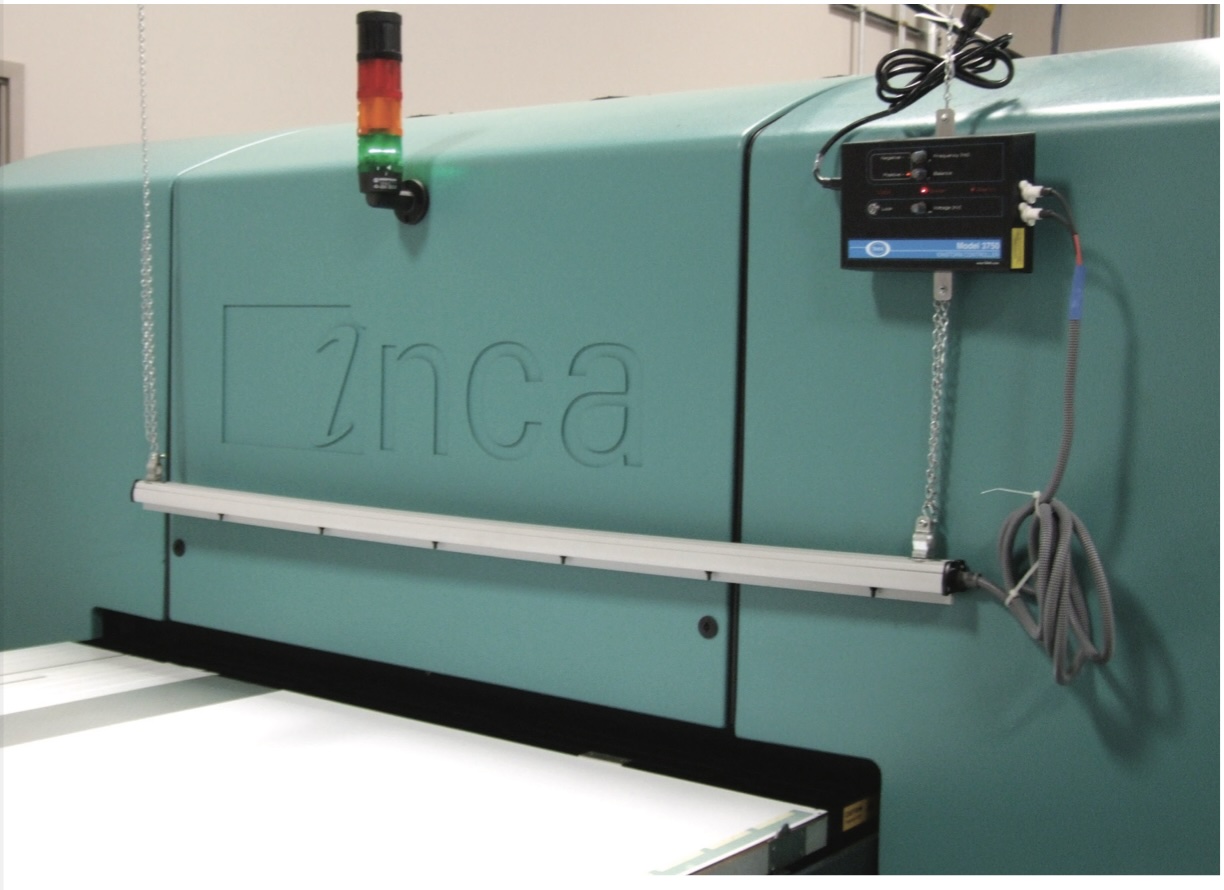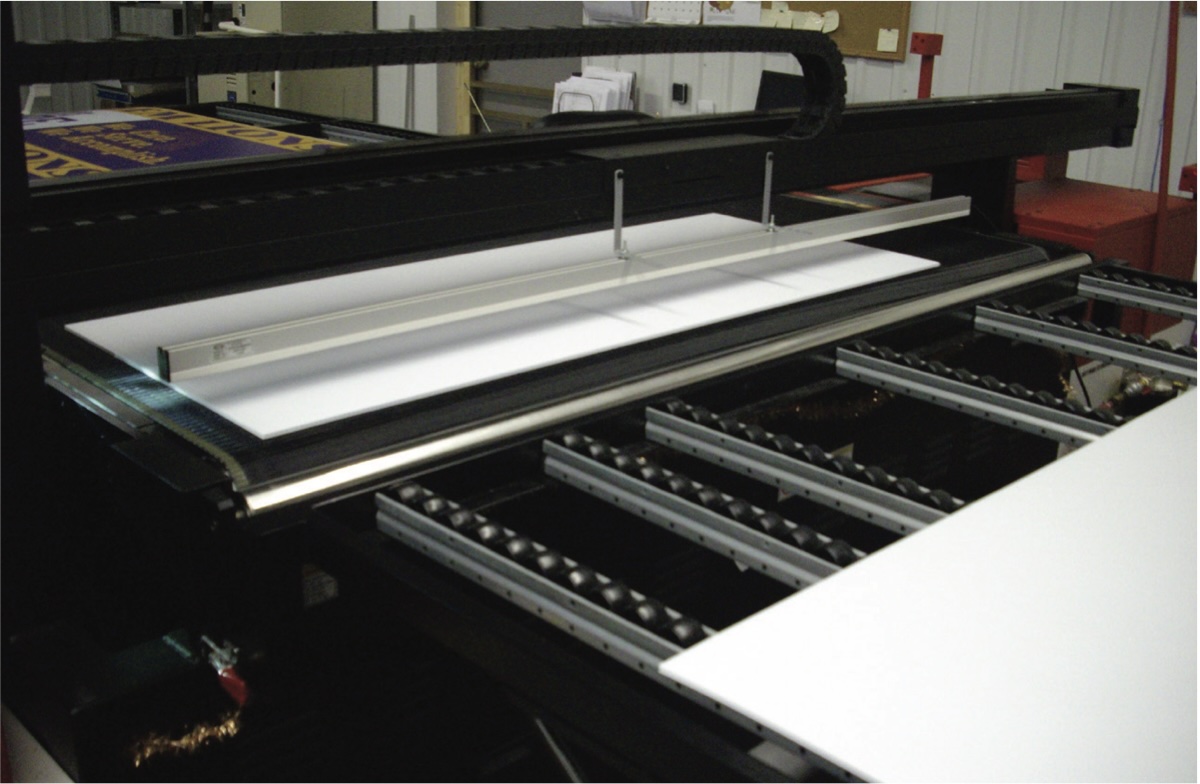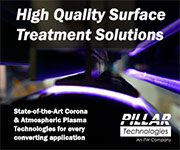Static and Static Controls in Printing
- Published: December 06, 2023
By Terrance Clark, National Technical Sales Manager, TAKK Industries Inc.
The negative effects of static in printing operations can result in serious consequences if not managed correctly. Static electricity charges can cause issues with print quality and volume of output. As the demand for faster production speeds and higher quality output continues to rise, it is imperative that printers have effective methods for combating static.
Theory of Electro-Static Charges
 The generation of static electricity has long been thought to be purely a frictional phenomenon. However, the words “Contact” and “Separation” may more accurately describe the mechanism by which static is generated.
The generation of static electricity has long been thought to be purely a frictional phenomenon. However, the words “Contact” and “Separation” may more accurately describe the mechanism by which static is generated.
When two uncharged materials are placed or pressed into intimate contact with each other, the surface electrons of each material at the points of contact tend to mix with each other, and to assume a different arrangement than they normally possess in the individual materials. If the two materials are then separated rapidly by sliding one on the other, or pulling one off the other, the displaced electrons have difficulty redistributing themselves into their normal arrangement. This is particularly true when one or both materials are insulators or poor conductors of electricity. This separation will leave one of the materials positively charged and the other negatively charged.
There is the old axiom of electrostatics: “Like charges repel; opposite charges attract.” Knowing this, we can see why some static charged piles of paper seem to float in a jogger of a printing press, and why some act as if the sheets were glued together.
Static in printing operations can be caused by a variety of factors, which can make it a difficult problem to manage. Changes in humidity, substrate types, process speed and related factors can cause static to flare up unexpectedly. When combined with the basic causes of friction and pressure, it is understandable why controlling static in printing can be a challenging task.
In the printing field particularly, material types can also affect static issues. The substrates moisture content and ambient humidity also play a crucial role in static buildup. As sheets or webs are fed through a Converting or Printing process, friction between the rollers and different types of substrates can generate significant amounts of electrostatic energy. There are a number of variables that can contribute to generation of static electricity and the costly troubles static can cause printers and converters.
How to Test for Static
A handheld static meter is an ideal tool to measure the strength of a static field for problem-solving purposes. A static meter will measure the voltage levels and polarity on different parts of the printing press, such as rollers and sheets. This will help identify areas where static is building up and be a guide in finding the best solutions to mitigate it.
There are many different operating tests for static, however, that can be used in the field which will, in most cases, provide sufficient information to evaluate static problems in the printing industry. For example, on the delivery pile, when one sheet is lifted slightly at the edge and then pulled away from the pile, if there is static present, the second and third and fourth sheets will tend to drag off the pile with the first sheet. When static is not present, however, the first sheet will pull off easily and cleanly without any pull against the lower sheets.
Trouble Caused by Static
The impact of static in printing operations is significant in both the print quality and productivity.
Printing Press
Poor Feed & Register: On printing presses, static frequently causes trouble on the feeder. Static attraction between the sheets will cause the feeder to pick up two sheets at one time rather than a single sheet. It can also cause trouble as the sheet of paper moves down the feed board — it may be attracted to the press, causing the sheet to turn slightly sideways. This gives either poor register or trips the stopping mechanism on the press and stops the press.
Poor Jogging: Static can cause printed sheets to stick together, making it difficult for the jogger to properly align and separate them. This can lead to uneven edges and inconsistencies in the final printed product.
Excessive Offset: The attraction of one sheet of paper to the next, caused by a static charge, may be the underlying reason for excessive offset conditions. If static conditions are present, even though the other factors such as paper and ink are satisfactory, offsetting may still occur and be entirely beyond the power of the press operator to eliminate except by slowing down the press.
Slow Drying: Static conditions on the delivery pile will seriously slow drying of the printed sheet. The normal air “cushion” between each sheet when static is not present, is squeezed out when static conditions attract one sheet to the next. This reduces the air space between the sheets and slows evaporation. This slowed drying process can result in smudging, streaking or even complete adherence of sheets to one another.
Tracking: Tracking of the ink on the printed sheet occurs when static is present on the sheet and light or volatile inks are used. In this case, the ink fans out from the impression in the form of tiny feathers or crow’s feet.
Dust Attraction: The paper dust resulting from slitting, cutting or trimming operations may be attracted to the sheet when static is present.
Folders
In addition to static troubles on presses, static control equipment is frequently necessary to properly operate folding machines. In this case the paper may come from the presses loaded with static which of course causes trouble on the feeder. More frequently, however, static builds up on the sheet going through the first fold to such an extent that the sheet sticks after coming out of the first fold and will not go properly into the second fold. Trouble is also experienced in the final delivery with the folded sheet being attracted to the next sheet and sticking together to give poor jogging.
Sheeters
Static conditions frequently cause major quality or production issues on paper sheeters. As the sheeters frequently cut multiple rolls of paper at a time, and then use over-riding tapers on the lay-boy, so many sheets are pushed into the delivery box at one time. Static causes trouble at the cutting knife and as the different layers of paper are sliding on the over-riding tapes.
What Static Issues Cost the Printer
Static electricity has long been an issue in the printing industry, causing decreased production volume and quality. However, this problem is often dismissed as being a normal part of the printing process.
Implementing effective instruments for controlling static electricity can greatly improve the overall productivity and quality of printed materials. This includes reducing runnability issues, such as paper jams and misfeeds, improving ink transfer and color consistency, and minimizing dust attraction that can affect print quality.
Methods of Combating Static
There are several methods for combating static in printing operations. These methods are of varying effectiveness and popularity. All methods discussed below are effective to some extent in the control of static electricity. The type of application and the degree of static present will direct the best method for static control.
Preconditioning: Preconditioning involves treating the materials before they enter the printing process, using chemicals or conditioning agents that reduce the build-up of static. These chemicals can be applied through various methods such as spraying, dip coating or misting.
Humidification: Dry air can increase the build-up of static, therefore maintaining proper levels of humidity can help reduce it. This can be achieved with humidifiers or steamers.
Anti-Static Chemicals:
Anti-static chemicals supplied in aerosol cans, pump bottles or in bulk, can be dipped, wiped or sprayed. The chemical’s purpose is to allow the treated surfaces to attract and absorb moisture from the air, forming a thin layer that is static electrically conductive. Anti-static chemicals are commonly used as a stop-gap measure where only occasional static problems arise or where other conventional static eliminators are not feasible.
Ionization: The most widely used method of static control is ionization. Ionization is the process by which air molecules are broken down into ions of both positive and negative charges. The generated positive and/or negative ions interact with a static laden surface to reduce the static charge by returning the static charges to near electrical balance. Ionization for the purpose of static elimination is typically achieved by using the following methods:
Induction Ionization
 Ionization through induction involves bringing electrically grounded sharp metal points, usually made of copper, brass or conductive filaments close to a moving static-laden surface. An interaction between the electrostatic field and the sharp end of the conductive points, initiates and maintains an ionization process in the surrounding air, thus acting to reduce the static charges. The most common induction ionizers are copper static eliminating tinsel, anti-static brushes or cords.
Ionization through induction involves bringing electrically grounded sharp metal points, usually made of copper, brass or conductive filaments close to a moving static-laden surface. An interaction between the electrostatic field and the sharp end of the conductive points, initiates and maintains an ionization process in the surrounding air, thus acting to reduce the static charges. The most common induction ionizers are copper static eliminating tinsel, anti-static brushes or cords.
The three most evident limitations of induction type devices are:
1) The device must be kept in close, usually within 1/4-inch, to the static-laden surface to be most effective.
2) The inductive device requires a threshold voltage (approximately 2000 volts) to maintain the ionization process. Below this threshold voltage the induction device will cease to function and, thus, will not reduce the static charge below this point.
3) Dust, ink and similar contaminates require Induction ionizers to be replaced periodically.
On the other hand, induction devices are a low-cost method of static elimination and can benefit some applications.
Electric Ionization
Electrically powered static eliminators operate at voltages from about 4000 volts to 33,000 volts. Ionization is achieved by impressing high voltage on the sharp points of one or more emitters close to the electrically grounded targets. Because of the difference in electrical potential between the emitter and grounded targets, the air surrounding the emitters breaks down into both positive and negative ions.
One criterion for evaluating the capabilities of an electrical static eliminator is its ionization range. (The distance from the emitters to the static laden surface). The longer the ionization range, the higher the output of the static eliminator.
There are several types of electrically powered static eliminators, such as Static Eliminating Bars, Ionizing Air Guns, Air Nozzles and Static Eliminating Blowers, available in a wide variety of sizes, power levels and ranges. The availability of a multitude of static eliminator devices enables users to select the exact device needed to suit a larger or smaller area, to neutralize static from a greater or lesser distance, or to overcome mounting/installation difficulties.
Static eliminators are powered by AC or DC current. The decision to choose between AC and DC ionizers depends on factors such as the application, environmental conditions and cost. AC ionizers are typically used for more economical neutralization of static charges. DC ionizers generally offer higher static control capabilities, range and/or connectivity to machine controls like PLC or HMI’s.
In Conclusion
Uncontrolled static electricity has been, and is, a costly problem in the printing industry. There are many effective methods of static control that can be implemented. By doing so, not only can production quality and efficiency be improved, but profits can also be maximized.
About the Author
The article is a TAKK Industries publication, revised by Terrance Clark for PFFC. With more than 24 years of experience in the static control industry, Terrance lends his expertise in identifying the best solutions for each client’s specific static elimination and static pinning applications.












